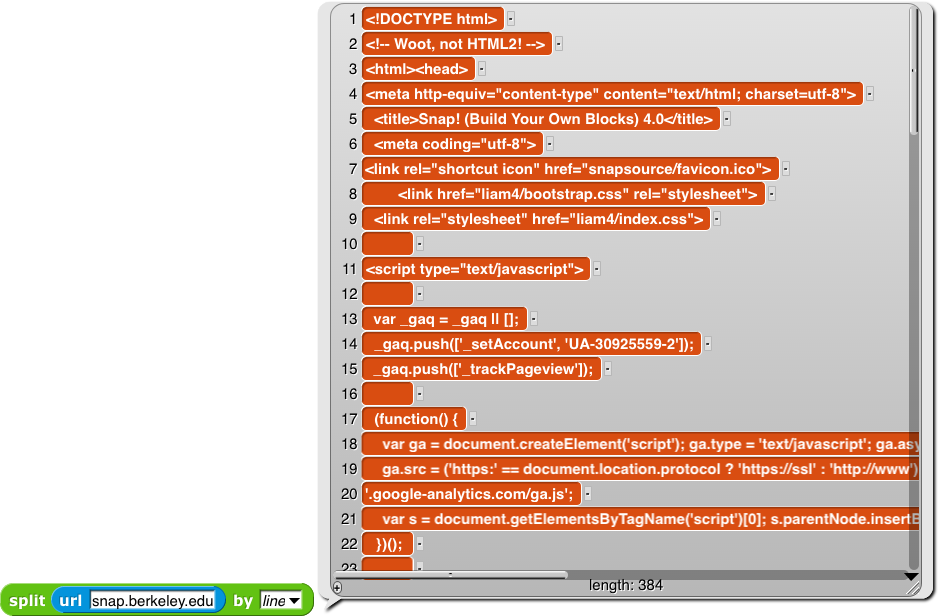9 The Outside World
The facilities discussed so far are fine for projects that take place entirely on your computer’s screen. But you may want to write programs that interact with physical devices (sensors or robots ) or with the World Wide Web . For these purposes Snap! provides a single primitive block:

This might not seem like enough, but in fact it can be used to build the desired capabilities.
The World Wide Web
The input to the url block is the URL (Uniform Resource Locator ) of a web page. The block reports the body of the Web server’s response (minus HTTP header), without interpretation. This means that in most cases the response is a description of the page in HTML (HyperText Markup Language) notation. Often, especially for commercial web sites, the actual information you’re trying to find on the page is actually at another URL included in the reported HTML. The Web page is typically a very long text string, and so the primitive split block is useful to get the text in a manageable form, namely, as a list of lines:

The second input to split is the character to be used to separate the text string into a list of lines, or one of a set of common cases (such as line, which separates on carriage return and/or newline characters.
This might be a good place for a reminder that list-view watchers scroll through only 100 items at a time. The downarrow near the bottom right corner of the speech balloon in the picture presents a menu of hundred-item ranges. (This may seem unnecessary, since the scroll bar should allow for any number of items, but doing it this way makes Snap! much faster.) In table view, the entire list is included.
If you include a protocol name in the input to the url block (such as http:// or https://), that protocol will be used. If not, the block first tries HTTPS and then, if that fails, HTTP .
A security restriction in JavaScript limits the ability of one web site to initiate communication with another site. There is an official workaround for this limitation called the CORS protocol (Cross-Origin Resource Sharing ), but the target site has to allow snap.berkeley.edu explicitly, and of course most don’t. To get around this problem, you can use third-party sites (“cors proxies ”) that are not limited by JavaScript and that forward your requests.
Hardware Devices
Another JavaScript security restriction prevents Snap! from having direct access to devices connected to your computer, such as sensors and robots . (Mobile devices such as smartphones may also have useful devices built in, such as accelerometers and GPS receivers.) The url block is also used to interface Snap! with these external capabilities.
The idea is that you run a separate program that both interfaces with the device and provides a local HTTP server that Snap! can use to make requests to the device. Unlike Snap! itself, these programs have access to anything on your computer, so you have to trust the author of the software! Our web site, snap.berkeley.edu, provides links to drivers for several devices, including, at this writing, the Lego NXT , Finch , Hummingbird , and Parallax S2 robots; the Nintendo Wiimote and Leap Motion sensors, the Arduino microcomputer, and Super-Awesome Sylvia ’s Water Color Bot . The same server technique can be used for access to third party software libraries, such as the speech synthesis package linked on our web site.
Most of these packages require some expertise to install; the links are to source code repositories. This situation will improve with time.
Date and Time
The current block in the Sensing palette can be used to find out the current date or time . Each call to this block reports one component of the date or time , so you will probably combine several calls, like this:

for Americans, or like this:

for Europeans.
